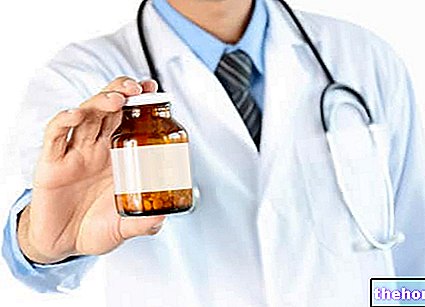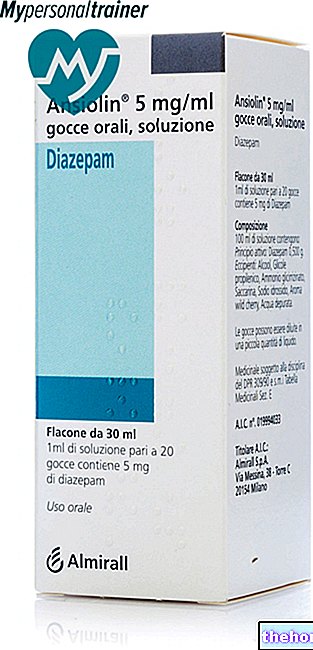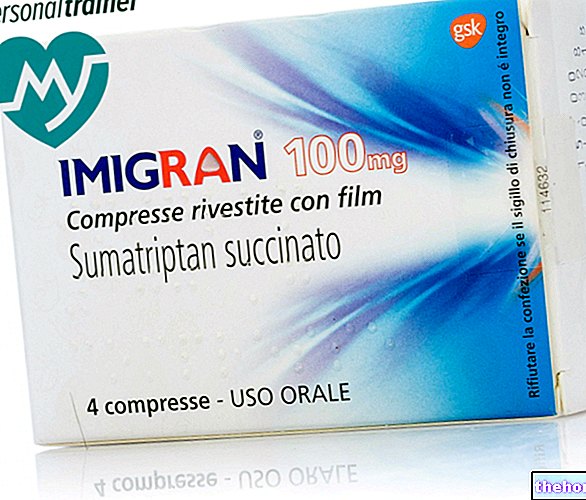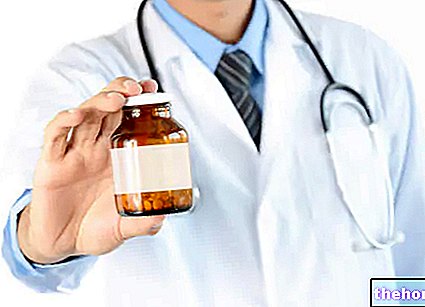Active ingredients: Thiamine, Riboflavin, Pyridoxine, Nicotinamide
Phosphorylase powder and solvent for solution for injection for intramuscular use
Why is Phosphorylase used? What is it for?
Phosphorylase contains as active ingredients some B vitamins and in particular: vitamin B1 (thiamine), vitamin B2 (riboflavin), vitamin B6 (pyridoxine) and vitamin B3 or PP (nicotinamide).
The solvent vial contains lidocaine hydrochloride, a local anesthetic that makes the injection of the medicine into the muscle less painful.
Phosphorylase is indicated:
- when there is a severe accumulation of toxic substances in the body such as in the case of accumulation of acids in the blood (diabetic and other toxicosis, loss of consciousness due to diabetes (diabetic coma),
- in the treatment of the inflammation of a nerve or of several nerves at the same time (neuritis and polyneuritis) toxic and infectious;
- in pregnant women who suffer from a disease called toxicosis gravidarum, even when this leads to eclampsia, a serious disease characterized by seizures, increased blood pressure, the presence of protein in the urine and swelling;
- in the toxicosis of infants or in the presence of "acetone" (acetonemic vomiting) a metabolic disorder typical of children.
Talk to your doctor if you don't feel better or if you feel worse.
Contraindications When Phosphorylase should not be used
Do not use / give your child Phosphorylase
- if you are allergic to vitamins B1, B2, B6, PP (Nicotinamide), lidocaine or any of the other ingredients of this medicine
Precautions for use What you need to know before taking Phosphorylase
Talk to your doctor or pharmacist before using / giving your child Phosphorylase
. Preparations based on vitamin B1 or derivatives, should be administered with caution in subjects who have had a history of previous drug reactions or other allergic diseases.
Interactions Which drugs or foods can modify the effect of Phosphorylase
Tell your doctor or pharmacist if you / your child are taking, have recently taken or might take any other medicines.
In particular, tell your doctor if you are taking levodopa (a medicine to treat Parkinson's disease).
Warnings It is important to know that:
Pregnancy and breastfeeding
If you are pregnant or breast-feeding, think you may be pregnant or are planning to have a baby, ask your doctor or pharmacist for advice before taking this medicine.
If you are pregnant or breast-feeding, use this medicine only under direct medical supervision.
Driving and using machines
Phosphorylase does not affect the ability to drive and use machines.
Phosphorylase contains methyl-ethyl parahydroxybenzoate and propyl-n-butyl-benzyl parahydroxybenzoate
It can cause allergic reactions (even delayed) and, exceptionally, bronchospasm.
Phosphorylase contains sodium
This medicine contains less than 1 mmol (23 mg) sodium per vial, ie it is essentially 'sodium-free'.
Dose, Method and Time of Administration How to use Phosphorylase: Posology
Always use / give your child this medicine exactly as your doctor or pharmacist has told you.
If in doubt, consult your doctor or pharmacist. The recommended dose is: 1-2 ampoules per day to be injected into a muscle.
Methods of preparation and administration
- with a sterile syringe withdraw the contents of the solvent vial
- put the contents of the solvent vial into the powder vial
- shake until you get a solution
- suck in the solution
- inject into the muscle
The solvent vial, containing Lidocaine Hydrochloride (a local anesthetic), makes administering the vitamin mixture less painful.
Overdose What to do if you have taken too much phosphorylase
If you use / give your child more Phosphorylase than they should
In case you / your child accidentally use large quantities of this medicine, please contact your doctor or go to the nearest hospital where they will arrange for adequate treatment.
If you forget to use / give your child Phosphorylase
Do not use / give your child a double dose to make up for a forgotten dose.
If you have any further questions on the use of this medicine, ask your doctor or pharmacist
Side Effects What are the side effects of Phosphorylase
Like all medicines, this medicine can cause side effects, although not everybody gets them.
Treatment with phosphorylase is generally well tolerated.
Reporting of side effects
If you get any side effects, talk to your doctor or pharmacist. This includes any possible side effects not listed in this leaflet. You can also report side effects directly via the national reporting system at https://www.aifa.gov.it/content/segnalazioni-reazioni-avverse.
By reporting side effects you can help provide more information on the safety of this medicine.
Expiry and Retention
Keep this medicine out of the sight and reach of children.
This medicinal product does not require any special storage conditions.
Do not use / give your child this medicine after the expiry date which is stated on the carton after EXP. The expiry date refers to the last day of that month.
Do not throw any medicines via wastewater or household waste. Ask your pharmacist how to throw away medicines you no longer use. This will help protect the environment.
What Phosphorylase contains
One vial of lyophilisate contains:
- The active ingredients are: Cocarboxylase 38.2 mg (equal to thiamine base 25 mg) - Riboflavin-5 "- monosodium monophosphate 3 mg - Pyridoxal-5- phosphate 1 mg - Nicotinamide 50 mg
- The other ingredients are: Methyl-ethyl parahydroxybenzoate, Propyl-n-butyl-benzyl phydroxybenzoate (See section Phosphorylase contains Methyl-ethyl parahydroxybenzoate and Propyl-n-butyl-benzyl parahydroxybenzoate)
One solvent vial contains:
- Lidocaine hydrochloride 20 mg, sodium citrate (See section Phosphorylase contains sodium), phenol, water for injections.
Description of Phosphorylase appearance and contents of the pack
Powder and solvent for solution for injection for intramuscular use Phosphorylase is packaged in a carton containing 5 powder ampoules plus 5 solvent ampoules
Source Package Leaflet: AIFA (Italian Medicines Agency). Content published in January 2016. The information present may not be up-to-date.
To have access to the most up-to-date version, it is advisable to access the AIFA (Italian Medicines Agency) website. Disclaimer and useful information.
01.0 NAME OF THE MEDICINAL PRODUCT
PHOSPHORYLASE POWDER AND SOLVENT FOR INJECTABLE SOLUTION FOR INTRAMUSCULAR USE - 5 LYOPHILIZED VIALS + 5 SOLVENT VIALS OF 2 ML
02.0 QUALITATIVE AND QUANTITATIVE COMPOSITION
A lyophilized vial contains:
Active ingredient: Cocarboxylase 38.2 mg (equal to thiamine base 25 mg) - Riboflavin -5 "- monosodium monophosphate 3 mg - Pyridoxal-5- phosphate 1 mg - Nicotinamide 50 mg.
One solvent ampoule contains: Lidocaine hydrochloride 20 mg.
03.0 PHARMACEUTICAL FORM
Powder and solvent for solution for injection for intramuscular use - 5 lyophilized vials + 5 solvent vials of 2 ml
04.0 CLINICAL INFORMATION
04.1 Therapeutic indications
Severe endogenous and exogenous toxicosis (diabetic and other toxicosis, diabetic coma, etc.). Toxic and infectious neuritis and polyneuritis. Toxicosis of pregnancy, eclampsia. Infant toxicosis, acetonemic vomiting.
04.2 Posology and method of administration
1-2 ampoules per day, intramuscularly.
04.3 Contraindications
Known individual hypersensitivity to the active ingredients or to any of the excipients of the pharmaceutical form.
04.4 Special warnings and appropriate precautions for use
Preparations containing vitamin B1 or derivatives can, particularly parenterally, cause disorders in those subjects who have had hypersensitization or morbid manifestations of allergopathy.
Keep this medicine out of the reach of children.
04.5 Interactions with other medicinal products and other forms of interaction
Particular caution must be observed in parkinsonian subjects treated with levodopa because high doses of vitamin B6 can antagonize its therapeutic effects.
04.6 Pregnancy and lactation
Although animal studies have not shown teratogenic effects, it is recommended to use the product under medical supervision.
04.7 Effects on ability to drive and use machines
Nobody.
04.8 Undesirable effects
Nobody.
04.9 Overdose
In case of overdose, keep the patient under observation and resort, if necessary, to the usual supportive therapies.
05.0 PHARMACOLOGICAL PROPERTIES
05.1 Pharmacodynamic properties
ATC code: A11JA
There cocarboxylase it works in the metabolism of carbohydrates as a coenzyme in the decarboxylation of alpha-ketoacids.
It also plays a particularly important role at the level of the central and peripheral nervous system, as its deficiency leads to encephalopathy and accumulation in the tissues of pyruvic acid and lactic acid. There riboflavin, in the coenzymatic forms of FMN (Flavin MonoNucleotide) and FAD (Flavin Adenin Dinucleotide), it assumes vital roles at the level of the mitochondrial respiratory chain; it is also of great importance in the liver, inducing many mechanisms of cellular detoxification.
There pyridoxine, in the coenzymatic form of pyridoxalphosphate, acts in many metabolic transformations of amino acids, such as decarboxylations, transaminations and racemizations, and attenuates the hepatic effects of corticosteroids, blocking their activity at the receptor level.
There nicotinamidefinally, it becomes part of the coenzymes delegated to cellular dehydrogenation reactions.
05.2 "Pharmacokinetic properties
There cocarboxylase it is distributed in most body tissues and is excreted in the urine as both thiamine and pyrimidine. The relative quantity of the latter decreases as the dose of cocarboxylase ingested increases.
There riboflavin it is distributed to all fabrics, but only small quantities can remain in the form of a deposit. It is excreted in the urine in essentially unchanged form.
There pyridoxine it is mainly excreted as 4-pyridoxic acid and as pyridoxal phosphate.
Nicotinamide it is distributed in all tissues and is found in the urine as N-methylnicotinamide, N-methyl-2-pyridone-5-carboxamide, N-methyl-4-pyridone-3-carboxamide and nicotinuric acid.
05.3 Preclinical safety data
Acute toxicity
Subacute and chronic toxicity
Fetal toxicity
The product, administered to rabbits between the 6th and 21st day of gestation at a dose of 50 DTD / kg / day by IM route, did not cause alterations in the mother and offspring.
Carcinogenic activity
The product is composed exclusively of vitamin-like substances, widely present in the integral organism of mammals, and therefore any effect of carcinogenesis stimulation must be excluded. This is also validated by the fact that in the tests of prolonged administration (rabbits - dogs) there were no histological manifestations or abnormal biochemical activities.
06.0 PHARMACEUTICAL INFORMATION
06.1 Excipients
Methyl-ethyl-p-hydroxybenzoate - Propyl-n-butyl-benzyl-p-hydroxybenzoate - Sodium citrate - Phenol.
06.2 Incompatibility
There are no known incompatibilities with the use of the product.
06.3 Period of validity
2 years
06.4 Special precautions for storage
None under normal environmental conditions.
06.5 Nature of the immediate packaging and contents of the package
Case containing, in a special polystyrene interior, n. 5 yellow glass powder vials + 5 white glass solvent vials.
06.6 Instructions for use and handling
With the sterile syringe, aspirate the contents of the solvent vial and introduce it into the phosphorylase vial, re-aspirate the solution and give the injection intramuscularly.
07.0 MARKETING AUTHORIZATION HOLDER
POLIFARMA S.p.A. - Viale dell "Arte, 69 - 00144 ROME.
08.0 MARKETING AUTHORIZATION NUMBER
AIC: 013237033
09.0 DATE OF FIRST AUTHORIZATION OR RENEWAL OF THE AUTHORIZATION
15-04-1983




























